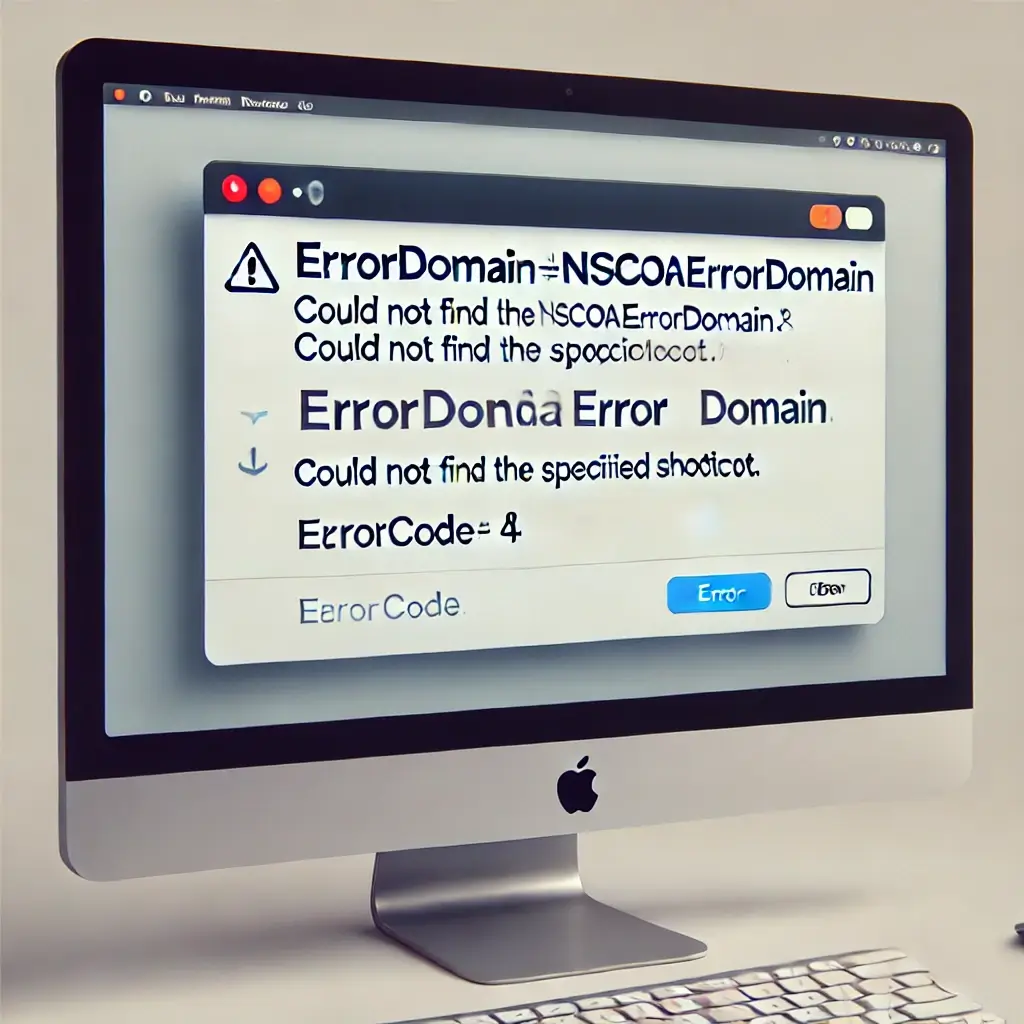When you’re using a Mac or any Apple device, sometimes, things don’t go as planned, and you might encounter frustrating error messages that are hard to understand. One such error message is:
errordomain=nscocoaerrordomain&errormessage=could not find the specified shortcut.&errorcode=4
This may sound like a technical mumbo-jumbo, but don’t worry. In this article, we will break down this error, explain its causes, and provide you with possible solutions in a simple, clear manner. If you’ve encountered this issue, you’re not alone, and there are ways to resolve it.
Read More Acronym Generator Alaika
What is the “errordomain=nscocoaerrordomain” Error?
If you’ve ever come across an error with the text “errordomain=nscocoaerrordomain”, you might have wondered what it means. Simply put, NSCocoaErrorDomain is a specific error domain in Apple’s programming language, Cocoa. This error domain is used to categorize different types of issues that occur within the macOS system or other Apple-related applications.
In basic terms, this is a system-level error, often indicating a problem with software communication or interaction, particularly with macOS’s application framework. It can be encountered in different scenarios, such as while accessing files, shortcuts, or applications. This error might seem vague at first, but the rest of the error message helps provide more clarity.
What Does the “Could Not Find the Specified Shortcut” Mean?
At the heart of this error is the message: “could not find the specified shortcut”. This message tells us that macOS or an application was trying to access a shortcut—whether it’s a file, folder, app shortcut, or custom command—but couldn’t find it.
Think of shortcuts as shortcuts to your favorite locations, files, or apps on your system. They’re like road signs guiding you to your destination. When the system can’t locate the “shortcut” you’re asking for, this error pops up.
This can happen for several reasons. Maybe the shortcut has been deleted, moved, or changed. It could also be a result of a file path issue or a glitch in the application or operating system.
Understanding the Role of Error Codes in Apple Systems
Every error in macOS, like in most software systems, comes with a unique error code. This code helps to pinpoint the specific issue that has occurred. Error codes can be a great tool for troubleshooting. They act as a way for the system to tell you exactly what went wrong behind the scenes.
When it comes to the “errordomain=nscocoaerrordomain&errormessage=could not find the specified shortcut.&errorcode=4” error, the code “4” plays a crucial role in identifying the problem.
Read More Canada SecurityScorecard Martin Bloomberg
What Is Error Code 4?
The number 4 in the error message is an important clue. It typically refers to a specific issue within the macOS system. Error code 4 often indicates a file not found problem or an issue with accessing a resource. In this case, it refers to a situation where a shortcut or file couldn’t be located at the expected location.
So, when you see error code 4, it’s essentially saying, “The system could not locate the shortcut or file you requested.” It’s like trying to find a book in a library, but the book is missing from the shelf where it should be.
How to Fix the “Could Not Find the Specified Shortcut” Error
Now that we understand the error, it’s time to discuss how to fix it. Here are a few simple steps that can help resolve this issue:
- Check the Shortcut: Ensure that the shortcut you’re trying to access still exists. If the original file or app was moved or deleted, the shortcut will no longer work. You can recreate the shortcut by locating the file or app manually and creating a new shortcut.
- Reboot Your Mac: Sometimes, a simple restart can clear up temporary glitches that may cause this error. Rebooting resets the system and clears any minor issues.
- Clear System Caches: Cached files might be causing conflicts. Use a cleaning tool or manually clear the cache to see if this resolves the error.
- Recreate the Shortcut: If the shortcut is broken, delete the current one and recreate it. Ensure that you’re linking it to the correct file or application.
- Software Update: Make sure your macOS is up to date. Apple often releases updates that fix known bugs and improve system stability.
Checking Your System Settings for Errors
System settings can sometimes play a role in the occurrence of errors. For example, if certain security settings are enabled, it might restrict access to certain shortcuts or files. Check your Security & Privacy settings to ensure there are no permissions issues blocking your access to the desired shortcut.
Read More OVHcloud: Comprehensive Analysis of France’s Leading Cloud Provider
The Role of NSCocoaErrorDomain in Mac OS
As mentioned earlier, NSCocoaErrorDomain is an error domain in macOS, used for categorizing a variety of system issues. It deals specifically with errors that occur when interacting with Cocoa-based applications or services. If you’re seeing errors related to NSCocoaErrorDomain, it could indicate problems in how applications are interacting with system resources.
Common Causes of This Error
Several factors can contribute to this error, such as:
- Deleted or Moved Shortcuts: If the file or application associated with the shortcut has been deleted or moved, the shortcut will be broken.
- Corrupted Files: Sometimes, files linked to shortcuts can become corrupted, causing this error to appear.
- Software Glitches: Bugs in the macOS system or in third-party applications can result in this error.
- Permission Issues: If your system doesn’t have the correct permissions to access certain files, shortcuts might not function correctly.
How to Troubleshoot This Issue
Troubleshooting this error involves a step-by-step approach. Start by checking if the shortcut points to the correct location. Then, check if the file or application is still present in the location. If not, recreate the shortcut or fix the file path.
Can This Error Affect Your Mac’s Performance?
Typically, errors like this won’t have a direct impact on your Mac’s overall performance. However, if left unresolved, they can lead to confusion and frustration. Over time, broken shortcuts may add to system clutter, leading to minor slowdowns. It’s a good idea to address these errors as soon as they arise to maintain your Mac’s smooth operation.
How to Avoid the “errordomain=nscocoaerrordomain” Error in the Future
While you can’t always prevent errors from happening, there are a few steps you can take to reduce the chances of encountering them:
- Regularly Update Software: Keep your macOS and apps updated to avoid known bugs.
- Organize Your Files: Keep your files and shortcuts organized to prevent unintentional deletions or movements.
- Check Permissions: Make sure your system permissions are correctly set for accessing various files and applications.
The Impact of Software Updates on Error Fixes
Apple is known for regularly releasing software updates that address various bugs, including those in the NSCocoaErrorDomain. Keeping your system updated ensures you have the latest patches and bug fixes that can help prevent or resolve errors like this.
Seeking Professional Help for Persistent Errors
If you’re unable to resolve the error on your own, it might be time to seek professional help. An Apple technician or expert can help diagnose and fix deeper system issues that may be causing persistent errors.
Resetting Your Mac to Resolve Errors
If all else fails, performing a system reset might be the solution. This will return your Mac to its factory settings, eliminating any errors caused by software or system corruption. Be sure to back up your important files before proceeding with a reset.
Read More G15Tool com Gadgets
Final Thoughts and Conclusion
Encountering errors like “errordomain=nscocoaerrordomain&errormessage=could not find the specified shortcut.&errorcode=4” can be frustrating, but with the right steps, you can easily resolve the issue. Whether it’s checking file paths, updating software, or adjusting settings, these solutions can help you fix the error quickly. Remember, staying organized and keeping your system updated are key to preventing future issues.
FAQs
1. What is NSCocoaErrorDomain in macOS?
NSCocoaErrorDomain is a category of errors in macOS related to the Cocoa framework, which manages the interaction of applications with system resources.
2. Why am I seeing error code 4 on my Mac?
Error code 4 usually refers to a missing or corrupted file or shortcut. It indicates that macOS could not locate the requested file.
3. How can I fix the “could not find the specified shortcut” error?
Try checking the shortcut’s file path, recreate the shortcut, and ensure that the file or application still exists.
4. Will this error affect my Mac’s performance?
No, this error won’t significantly affect overall system performance, but unresolved errors can lead to frustration and minor slowdowns.
5. Should I contact Apple Support for help with this error?
If you’re unable to fix the error yourself, contacting Apple Support or a professional technician is a good option for further assistance.





 Ramadan DP with Quotes: A Unique Way to Express Your Spirituality
Ramadan DP with Quotes: A Unique Way to Express Your Spirituality